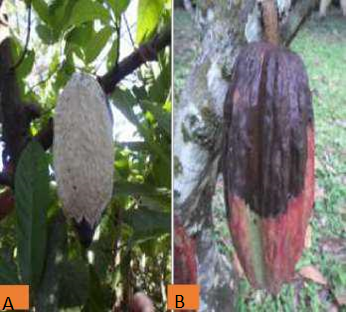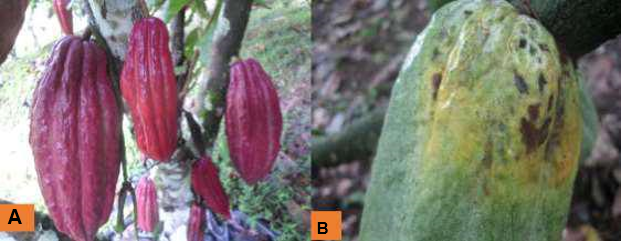eISSN: 2576-4462


Research Article Volume 7 Issue 1
Agronomist Engineer, Private advisor, Colombia
Correspondence: Gabriel Cubillos, Agronomist Engineer,Private advisor, Medellín, Colombia, Tel +56-317785086,
Received: February 13, 2023 | Published: February 23, 2023
Citation: Cubillos G. Model of cultural control of the Cacao Frosty Pod Rot disease (Moniliophthora roreri (CIF & Par) Evans et al)1. Horticult Int J. 2023;7(1):6-7. DOI: 10.15406/hij.2023.07.00268
The Cacao Frosty Pod Rot (Moniliophthora roreri (Cif. & Par.) Evans et al)1 is a disease with the greatest impact on cacao crop yields in Central and South America. It was recently detected in the state of Acre, Brazil. Although its control has been proven in various ways, cultural control has been checked to be the most effective and economical. The proposed model is based on the recognition of the critical states of the fruits as sources of infection, the disease cycle, the timely removal of diseased fruits and their free disposal on the soil.
Cacao Frosty Pod Rot, also known in Spanish as Monilia, Moniliasis, Mancha, Ceniza, Polvillo, Hielo, Pringue, Pasmo, Malaria and Pudrición aguanosa, among others (Figure 1), caused by the fungus Moniliophthora roreri (Cif. & Par.) Evans et al.,1 is the disease with the greatest impact on the yields and quality of the raw material in Central and South America. Its presence has already been reported in Jamaica, an island in the Antilles, and in the state of Acre, southern Brazil.
In Colombia, the Cacao Frosty Pod Rot has been known since 1817, Phillips-Mora,2 and is widespread in all cultivation areas, causing damage especially in the main producing departments such as Santander del Sur, Santander del Norte, Antioquia, Arauca, Meta, Huila, Tolima and Nariño.3
Cacao growers must apply the cultural control model proposed in this manuscript as the most effective, simple, cheap mechanism, in harmony with the environment and sustainable over time. In this way, the resources of all the genetic material established in the country take advantage of it without having to resort to new plantings exclusively with limited materials known as resistant.
During the Campaigns against the Cacao Frosty Pod Rot carried out in Colombia in the years 2005-2006,3,4 it was verified that its incidence in the main producing departments fluctuates between 38.6-84.1% according to the climate, intensity of the rainy seasons and the phytosanitary management that the grower gives to his crop. In the year 2021-2022 the production fell 10.6% (7,464 metric tons) in part as a result of the high incidence of the disease (data from National Federation of Cacao Growers). In the Figure 2 it can appreciate the damage that Frosty Pod Rot caused in a harvest round of the El Placer farm, municipality of San Vicente de Chucurí (department of Santander, Colombia) in October 2021.

Figure 2 Harvest round of ripe pods with a high incidence of Frosty Pod Rot. Farm El Placer, municipality of San Vicente de Chucurí (Santander, Colombia). Year 2021.
The cultural control is based on the knowledge of the critical states of the diseased fruits as sources of contagion and on the interruption of the disease cycle subject to the timely removal of the diseased fruits.
The diseased fruits as internal sources of contagion are those that are in states of sporulation and brown spots (Figure 3). The former because they operate as active sources of contagion and the latter because in a period of seven-nine days they become new active sources of contagion.

Figure 3 The fruits infected with Frosty Pod Rot. A, in a state of recent sporulation. B, in a state of brown stain.
The fruits with other symptoms of Frosty pod rot such as bellies or humps and with small oily spots under the epidermis (Figure 4) are not in a critical state because they take between 3-4 weeks to reach these stages of infection.

Figure 4 The fruits with other symptoms of Frosty Pod Rot. A, central fruit with shiny bellies or humps. B, tiny oily spots beneath the epidermis of the fruit.
The cycle of Frosty Pod Rot from the moment of an infection to sporulation is two and a half months. This means that if it apply an effective control mechanism, the results will only become evident after that time.
The cultural control of Frosty Pod Rot consists of judiciously unhung diseased fruits in states of recent sporulation and brown spot, every week for two and a half consecutive months.5 Naturally, during this operation the mummified fruits with scabs of sporulation or fruits with symptoms of bellies or oily spots under the epidermis must also be removed when they are detected.
After that time, the diseased fruits detach when harvests are made from the mature fruits, normally every two or three weeks because the disease cycle already was broken.
The diseased fruits removed from the trees are left freely on the ground so that they are naturally decomposed by the micro and macro-organisms that are found there, without the risk of triggering new outbreaks of infection.
The best indicator of the effectiveness of this cultural control mechanism is the absence or minimal presence of sporulated fruits within the cacao crop, as the main sources of contagion.1
A practice that is joined with cultural control is pruning because it facilitates the detection of diseased fruits, saving time in their search inside the trees. This task is normally done after the main harvest is finished.
In Colombia there are production records of two farms that have applied this Frosty Pod Rot control model. The first is of the La ILusión farm, located in the municipality of Chigorodó, department of Antioquia, with an area of 1 hectare and 8 years of age, whose incidence of Frosty Pod Rot stayed below 20% in the period 2019-2022 (Table 1).
|
Year |
Production in Kilograms |
Incidence of frosty pod rot Estimated % |
|
|
2019 |
1.651 |
˂ 1 |
|
|
2020 |
1.932 |
˂ 1 |
|
|
2021 |
820 |
20 |
|
|
2022 |
1.116 |
2-3% |
|
Table 1 Production records of La ILusión farm, municipality of Chigorodó (department of Antioquia, Colombia), with 1 hectare and 8 years old
And the other is of the San José farm, located in the municipality of San Vicente de Chucurí, department of Santander, with an area of 18 hectares and 11 years old, whose incidence stayed below 18% in the period 2017-2022 (Table 2).
|
|
Kilograms/ha. |
Estimated incidence of frosty pod % |
|
2017 |
1.138 |
˂ 10 |
|
2018 |
945 |
˂ 10 |
|
2019 |
964 |
˂ 10 |
|
2020 |
976 |
˂ 10 |
|
2021 |
1.041 |
10-18 |
|
2022 |
779 |
18 |
Table 2 Production records of San José farm, municipality of San Vicente de Chucurí (department of Santander, Colombia) with 18 hectares and 11 years old
None.
All the authors declare that there is no conflicts of interest.

©2023 Cubillos. This is an open access article distributed under the terms of the, which permits unrestricted use, distribution, and build upon your work non-commercially.